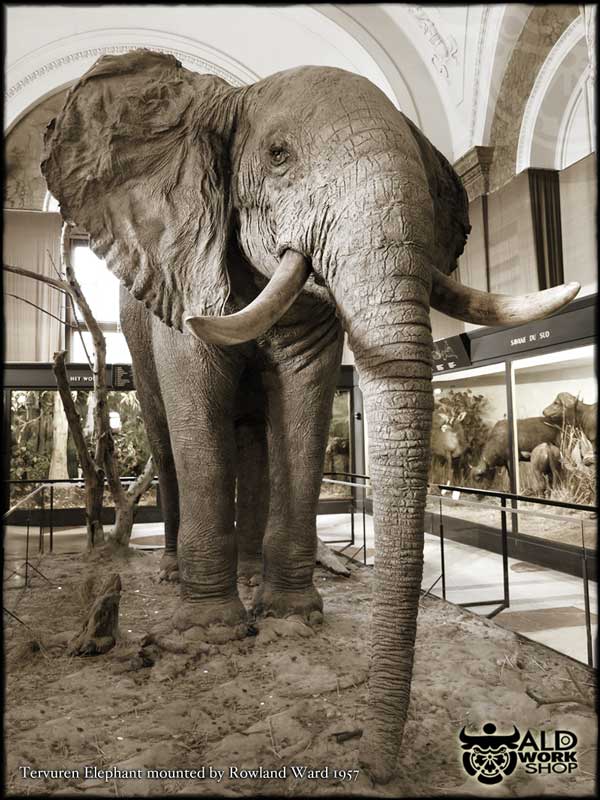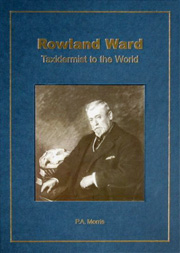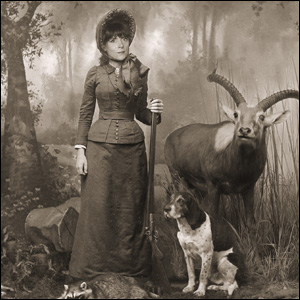
The African bush elephant, Loxodonta africana, has long been a symbol of the Royal Museum for Central Africa, Tervuren. What were the historical process and spatial practices that led up to the transformation of this animal from Africa to Brussels and from previously living animal into museum display of nature ?

The African bush elephant, Loxodonta africana, symbol of the Royal Museum for Central Africa.
The specimen, obtained in the Kasai province of the Belgian Congo was mounted by London taxidermists Rowland Ward Ltd. to the orders of the Belgian Government, to take an honoured place in the 'Palais de la Faune du Congo' at the 1958 Brussels Universal and International Exhibition, along with a selection of about twenty other large mammals.
Subsequently the specimens were transferred to the Musée Royal du Congo Belge in Tervuren, which would ultimately become the Royal Museum for Central Africa in 1960.
As part of the museum's exhibit modernization program a series of natural history dioramas were created, presenting the taxidermied specimens in an illusionary wildlife habitat arranged according to the geographical origin of Congo's most important and rare animals. The habitat displays remained on view for a quarter of a century until they were dismantled in 2013, when the museum embarked on an extensive major refurbishment.
This site takes a look at some of museum dioramas and specimens mounted by Rowland Ward Ltd for the Museum of Tervuren (RMCA).
♥ The Africa Museum in Tervuren has been superbly renovated and opened again December 2018.
Royal Museum for Central Africa, Tervuren
In 19th Century Europe taxidermic animal displays became useful and interesting in natural history museums and international exhibitions for educational and entertainment purposes in an age long before the advent of wildlife photography, motion pictures, television and computer technologies.
Taxidermy is a fundamental method of preserving animals and has long played an important role in building museum's zoological collections for scientific study rather than exhibition. Natural history collections are a source of knowledge and many contain unique specimens that cannot be collected again easily – or at all, in some cases. Despite changing social attitudes to the display and use of an animal's dead body, the museum's scientific collection continues to function as an essential resource for study both now and for future generations of zoologists.
The art of taxidermy – a profession often overlooked and misjudged – is not about reanimation of a dead animal. Zoological collections provide an invaluable insight into both the social and the scientific role taxidermy has played over the years. The work of a taxidermist is a technical and highly artistic skill with the object of producing an animal that shows the beauty and drama of a living animal. On closer inspection, the mounted specimen reveals the secret of its assembly: showing how materials and techniques employed by taxidermists have evolved through time, with examples of high quality mounts alongside early nineteenth century styled specimens.
Sadly, taxidermists have received little credit for their efforts and biographical information on individuals is therefore very scant. Yet it is increasingly recognised that taxidermy and the scientific preservation of animals form an important part of the history of natural history, inviting curiosity about one of the most famous contributors in this area.

Nine chapters describe the man himself and his early days in business, the taxidermy workshops during the 20th century and the principal personalities that worked there. Separate chapters cover big game whole mounts, head mounts and birds, with sections on fish taxidermy and 'Wardian' animal furniture. There is also a collation of the many different label types used by Rowland Ward Ltd. for their products. The text, of 55,000 words, is based on more than 20 years research, interviews with former employees and much unpublished material. Over 250 illustrations include line drawings monochrome photographs and copies of old documents.

Artist Photographer, Graphic Designer, and researcher focused on the history of taxidermy and natural history collections, with a special interest in 19th century culture.
Annick @ Aldoworkshop is not affiliated with the Royal Museum for Central Africa, rather a natural history enthusiast dedicatedly passionate about the Royal Museum for Central Africa.